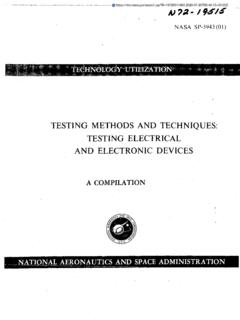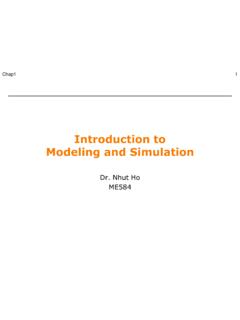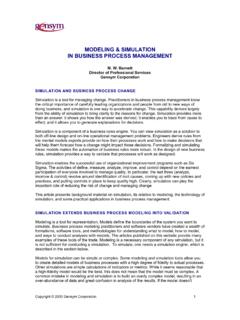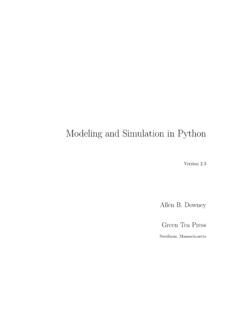Transcription of Additive Manufacturing Modeling and Simulation …
1 April 2014 NASA/TM 2014-218245 Additive Manufacturing Modeling and Simulation A Literature Review for Electron Beam Free Form Fabrication William J. Seufzer Langley Research Center, Hampton, Virginia 2020-08-04T18:43:13+00:00Z NASA STI Program .. in Profile Since its founding, NASA has been dedicated to the advancement of aeronautics and space science. The NASA scientific and technical information (STI) program plays a key part in helping NASA maintain this important role. The NASA STI program operates under the auspices of the Agency Chief Information Officer. It collects, organizes, provides for archiving, and disseminates NASA s STI.
2 The NASA STI program provides access to the NASA Aeronautics and Space Database and its public interface, the NASA Technical Report Server, thus providing one of the largest collections of aeronautical and space science STI in the world. Results are published in both non-NASA channels and by NASA in the NASA STI Report Series, which includes the following report types: TECHNICAL PUBLICATION. Reports of completed research or a major significant phase of research that present the results of NASA Programs and include extensive data or theoretical analysis. Includes compilations of significant scientific and technical data and information deemed to be of continuing reference value.
3 NASA counterpart of peer-reviewed formal professional papers, but having less stringent limitations on manuscript length and extent of graphic presentations. TECHNICAL MEMORANDUM. Scientific and technical findings that are preliminary or of specialized interest, , quick release reports, working papers, and bibliographies that contain minimal annotation. Does not contain extensive analysis. CONTRACTOR REPORT. Scientific and technical findings by NASA-sponsored contractors and grantees. CONFERENCE PUBLICATION. Collected papers from scientific and technical conferences, symposia, seminars, or other meetings sponsored or co-sponsored by NASA. SPECIAL PUBLICATION. Scientific, technical, or historical information from NASA programs, projects, and missions, often concerned with subjects having substantial public interest.
4 TECHNICAL TRANSLATION. English-language translations of foreign scientific and technical material pertinent to NASA s mission. Specialized services also include organizing and publishing research results, distributing specialized research announcements and feeds, providing information desk and personal search support, and enabling data exchange services. For more information about the NASA STI program, see the following: Access the NASA STI program home page at E-mail your question to Fax your question to the NASA STI Information Desk at 443-757-5803 Phone the NASA STI Information Desk at 443-757-5802 Write to: STI Information Desk NASA Center for AeroSpace Information 7115 Standard Drive Hanover, MD 21076-1320 National Aeronautics and Space Administration Langley Research Center Hampton, Virginia 23681-2199 April 2014 NASA/TM 2014-218245 Additive Manufacturing Modeling and Simulation A Literature Review for Electron Beam Free Form Fabrication William J.
5 Seufzer Langley Research Center, Hampton, Virginia Available from: NASA Center for AeroSpace Information 7115 Standard Drive Hanover, MD 21076-1320 443-757-5802 Acknowledgments The author wishes to thank Karen Taminger and Robert Hafley for commissioning this literature review. The process of compiling this report has been a valuable learning exercise. The use of trademarks or names of manufacturers in this report is for accurate reporting and does not constitute an official endorsement, either expressed or implied, of such products or manufacturers by the National Aeronautics and Space Administration. iiiAbstract Additive Manufacturing is coming into industrial use and has several desirable attributes.
6 Control of the deposition remains a complex challenge, and so this literature review was initiated to capture current Modeling efforts in the field of Additive Manufacturing . This paper summarizes about 10 years of Modeling and Simulation related to both welding and Additive Manufacturing . The goals were to learn who is doing what in Modeling and Simulation , to summarize various approaches taken to create models, and to identify research gaps. Later sections in the report summarize implications for closed-loop-control of the process, implications for local research efforts, and implications for local Modeling efforts. iv THIS PAGE INTENTIONALLY LEFT BLANK vTABLE OF CONTENTS SECTION 1 OVERVIEW.
7 1 SECTION 2 ENERGY INSERTION .. 2 SECTION 3 MOLTEN POOL .. 4 Molten Pool Physics Based Models .. 4 Molten Pool Process Maps .. 5 SECTION 4 MICROSTRUCTURE EVOLUTION .. 7 SECTION 5 RESIDUAL STRESS .. 9 SECTION 6 MECHANICAL PROPERTY PREDICTION .. 10 SECTION 7 DEPOSITION Modeling .. 12 SECTION 8 DEPOSITION CONTROL .. 14 SECTION 9 EVALUATION OF THE LITERATURE POOL .. 16 Implications for CLC .. 16 Implications for Process Related Research .. 16 Implications for Modeling Efforts .. 17 SECTION 10 REFERENCES .. 18 vi LIST OF TABLES Table 1. Faraday cup and beam energy distribution.. 3 Table 2. Molten pool physics.. 5 Table 3. Molten pool process maps.. 6 Table 4. Microstructure evolution.
8 8 Table 5. Residual stress.. 10 Table 6. Mechanical property prediction.. 10 Table 7. Deposition Modeling .. 13 Table 8. Deposition control.. 15 viiNomenclature 2 D two dimensional 3 D three dimensional AM Additive Manufacturing ANN artificial neural network ASME American Society of Mechanical Engineers CA cellular automata CLC closed loop control DOE design of experiments EB electron beam EBF3 electron beam free form fabrication FE finite element (model) FV finite volume (model)
9 GA genetic algorithm GGF greedy geometric feedback GTAW gas tungsten arc welding ICME integrated computation materials engineering ILC iterative learning control LB lattice Boltzmann LENS laser engineered net shaping M&S Modeling and Simulation PSO particle swarm optimization SFF solid freeform fabrication 1 SECTION 1 OVERVIEW Additive Manufacturing (AM) is coming into industrial use and has several desirable attributes. For example, it may be possible to control microstructural features through variations in Additive processing parameters (ref.)
10 1). If microstructure can be controlled then AM could contribute to a goal of the integrated computational materials engineering (ICME) community. ICME has a goal to deliver designer materials based on performance requirements (ref. 2). In addition to providing designer materials, Additive Manufacturing will also enable unique part design by removing some Manufacturing process constraints (ref. 3). While other challenges such as certification must be overcome for everyday use, this paper will focus on what is currently being done to understand the deposition process through Modeling and Simulation (M&S). The published literature on laser-based Additive Manufacturing appears more extensive than electron beam-based wire deposition.



















